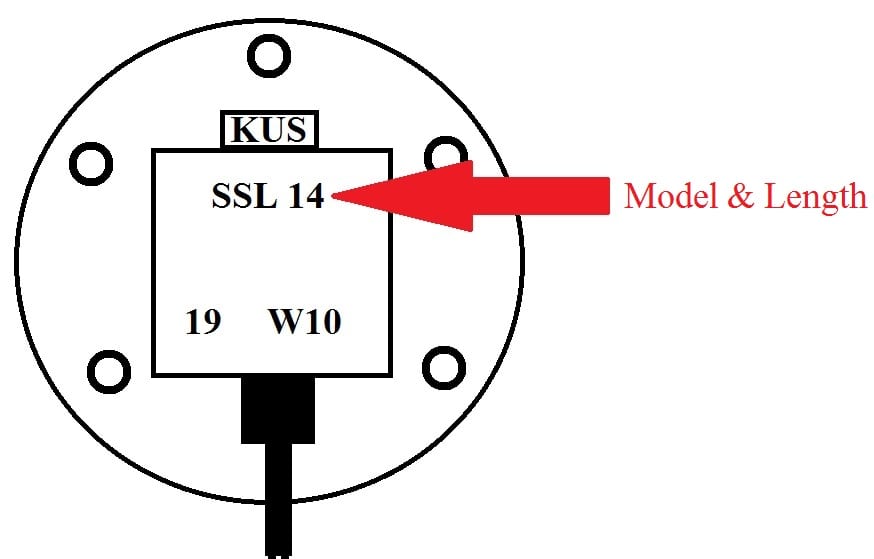Frequently Asked Questions
General Questions
KUS Sending Units
To identify your current KUS sending unit, please look at the model number on the aluminum cap at the top of the unit (where the wires are).

KUS Gauges
To identify your current KUS gauge, please look at the sticker on the back of the gauge for the model & part number.

If you do not have a KUS sending unit and need to identify a KUS replacement for your unit, please contact us the following information:
- Tank Depth/Current sender length.
- Output/Operating ohms range.
- Mounting style. (How the unit mounts to the tank)
Our standard sending units have two wires:
- Pink connects to ground
- Black connects to the gauge.
For further clarification please see our Sending Unit Installation Guide.
Our standard liquid level gauges have 5 wires:
- Red connects to power
- Blue connects to ground
- Black connects to the sending unit
- Yellow and Orange connect to power for the backlight options.
Please refer to the gauge installation instructions for further clarification.
Please contact us if your sending unit/gauge has additional or alternate wire colors.
To test the ohms range on a sending unit:
- Connect your unit to an ohm meter or multimeter.
- Ensure your meter is set to Resistive 2000 (2k) ohms.
- Position the float at the empty position and manually move it from empty to full.
- For American Standard sending units the unit will read 240 at empty and 33 at full (+/- 5 ohms).
- For European Standard sending units, the unit will read either 0 or 10 at empty and 180, 190 or 90 at full (+/- 5 ohms).
To test the ohms on your gauge:
- Make sure the Power to the gauge is not on.
- Disconnect the black wire to the sending unit, at the gauge end. Note, you may have to cut the wire (you can always re-connect it later). Leave enough wire at the gauge end to work with. Do not cut it too short.
- With the black wire disconnected, turn the 12 VDC power to the gauge ON.
- The gauge needle, will:
- On the American version gauge (240 . 30 ohms), stay at Empty. Ground the black wire (at the gauge end), and the needle will go to Full.
- On the European version gauge (0 . 180 ohms), go to Full. Ground the black wire (at the gauge end), and the needle will go to Empty.
To make a warranty or non-warranty return please contact us for a returns good authorization number. Please also include a picture of the top of your sending unit or the back of your gauge, and any invoice, purchase order or sales order information.
Please note the following information when making a return:
Improper parts installation, or use of seals with corrosive additives or mixtures, could cause seal failure and subsequent leaks. Modification of the original part design, mishandling of product, or purchasing a sender size that will touch the tank bottom, sides or baffles, will void the warranty.
Warranty claims or returns will not be processed without a KUS USA, Inc Return Goods Authorization number (RGA). All warranty claims must be processed in accordance to our procedural outline and warranty policy.
All non-warranty returns will be subjected to a 20% restocking fee.
Please contact us to process an order with a FL sales tax certificates.
Please note that our webstore automatically includes taxes for Florida orders.
Unfortunately, at this time we do not allow walk in/pick up customers at our location. We do however offer free ground shipping in the state of Florida when placing an order through our online system.
For troubleshooting instructions please see our Troubleshooting Guide
Liquid Level Sending Unit Questions
For additional specifications of the sending units please select “Product Data Sheets” under the Support Tab or click here.
We offer the following outputs for our sending units:
- Resistive (ohms) – American Standard: 240-33 (available online), European Standard: 0-180, 10-180, 0-190, 0-90 (contact us for pricing and availability)
- 4-20 mA (contact us for pricing and availability)
- 0-5 volts or 0.5-4.5 volts (contact us for pricing and availability)
- Digital Signals such as J1939, RS232, RS485, CanBUS (contact us for pricing and availability)
We offer the following customization’s for our units, please contact us for pricing and availability.
- Ullage
- Special Ohms Range Calibrations
- Hi/Low Switches
- Linear Resolution
- Plugs (MetriPak & Deutsch)
We offer the following gaskets for the SSS/SSL units:
- Cork/Nitrile
- Nitrile
- Viton
Please click here to order a Gasket Mounting Kit.
The float is NBR material.
To clean the SHS/SHST remove the unit from the tank, and cautiously remove the bell shaped pin at the bottom of the unit. Once the pin is removed the outer casing can be removed from the sending unit. Clean the unit with water, NO HARSH CHEMICALS. Remove any blockages from unit that may interfere with the float. Reassemble unit and reinsert into tank.
Liquid level Sensors / Senders Questions
A liquid level sensor allows you to monitor how much liquid is in your tank at a given time using gauge instrumentation. It also lets you know when you need to refill a certain liquid. Some liquid level senders have more advanced features like triggering an alarm when your tank is nearing empty or having pick-up and return lines.
The liquid level sensor is connected to a gauge by a sender wire. It is also attached to a float, which moves with the liquid level in the storage tank. Together, this assembly tells your gauge how full the tank is. The liquid level sender changes resistance, measured in ohms as the liquid level drops and the float descends. Changes in resistance move the gauge needle.
Level sensors are found on virtually any gas-powered vehicle or machinery. There are many different types of level sensing technologies available on the market. Your choice will depend on the type of machinery, operating conditions, fuel consumption, and other factors.
These are the basic types of level sensing technologies.
- Resistance
- Capacitance
- Ultrasonic
- Digital
- Mechanical
You can learn more about how each works in our related blog post
The capacitance level sensor (CLS) is a liquid level sender used in on-road and off-road vehicles, industrial applications, and in generator sets. This multi-functional component uses capacitance technology to detect the liquid level. It provides high resolution — less than 1 millimeter — level detection by measuring the capacitance variance as liquid level changes.
Installing a liquid level sending unit is a multi-step process. You can view our guide on how to install a level sending unit for more information.
Power issues, wiring issues, moisture, and rust can all cause issues with the liquid level sensor. A fuel level sensor issue may cause the fuel gauge needle to become stuck on full or empty
Yes. However, you may not be able to accurately gauge how much liquid is left in the tank. Once you notice an issue (inaccurate/no gauge readings) we recommend that you troubleshoot your unit/gauge to find the issue or order a replacement unit as quickly as possible.
Diesel Exhaust Fluid (DEF)
Diesel exhaust fluid (DEF) is a non-hazardous solution used within a selective catalytic reduction (SCR) system to break down harmful pollutants (NOx) generated by a diesel engine. DEF is 32.5% urea, or aqueous ammonia solution, and 67.5% deionized water.
There are three major components in any SCR system. These include a DEF supply module or injector, a DEF tank assembly, and an SCR catalyst. The SCR system is one of the exhaust aftertreatment systems adopted by vehicle and engine manufacturers to reduce emissions..
If a truck runs out of DEF, then the vehicle speed reduces to 5 mph until the tank is refilled.
NMEA 2000 Questions
NMEA 2000 is the latest version of the NMEA communications standard for marine instruments that allows you to easily install and connect compatible devices within your vessel. Upgrading your boat console and devices to this standard simplifies the device integration process. A fully integrated NMEA 2000 system enhances navigation and provides better access to data.
NMEA is an acronym for the National Marine Electronics Association. This association is responsible for creating the NMEA 2000 communications standard for marine vessels..
NMEA 2000 certified devices are attached to the network via a central “backbone” cable using various connectors, such as T-connectors and drop cables. This setup reduces clutter and the ability to disconnect devices one at a time simplifies the troubleshooting process.
Most modern name brand large marine engines are NMEA 2000 compatible. Yes, an NMEA 2000 network requires electrical power, which is supplied by a 12-volt DC power source.
Yes. You can use special connectors to integrate older NMEA 0183 devices into your NMEA 2000 network. This allows you to upgrade NMEA 0183 devices on an as-needed basis. In order to get the full value out of your NMEA 2000 network, you will want to invest in newer devices.

